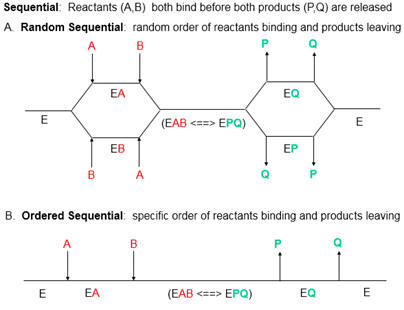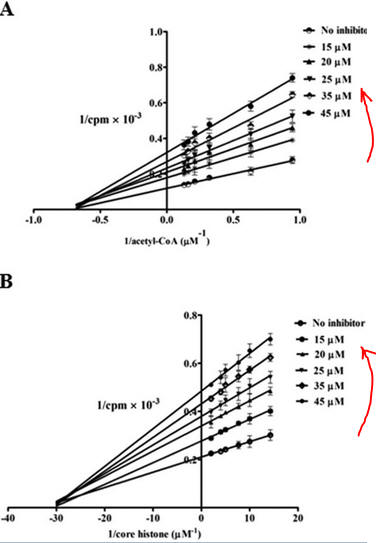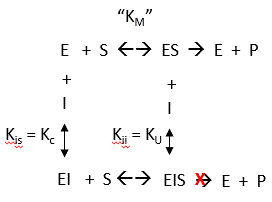Naphthoquinone-mediated
Inhibition of Lysine Acetyltransferase KAT3B/p300
Questions
7. How might PTK1 inhibit p300 KAT activity. Enzyme kinetic analyses would be
useful. The enzyme has two substates, acetyl CoA and histones. Previous studies
have shown that substrates bind to p300 , in an ordered mechanism. The
non-competitive inhibitor PTK1 could bind to the free enzyme as well as to the
substrate-bound form, resulting in an abortive ternary complex. T

Presume that added reversible inhibitors behavior in a similar fashion with
single and multi-substrate reactions. Here are some simple rules that apply to
double reciprocal plots (1/v vs 1/[S} when 1 substrate is kept constant:
The slope changes when:
- I and S bind to the same form of the enzyme (for example E binds
both S and I) OR
- I binds to a form of E (on the horizontal line) which is connected
to the form that S binds, and I binds first (for example, I binds to E and
then S binds).
The Y intercept changes when:
- I and S bind to different forms of the enzyme unless I binds first
and the binding of I and S are in rapid equilibrium.
Figure 7 AB: Figure 7 A and B below show double reciprocal or Lineweaver-Burk
plots (1/v vs 1/[S]) of p300 KAT with one substrate fixed and the other varying
at different fixed concentations of inhibitor PTK1.
- In Figure 7A, the concentration of core histones was kept constant at 1.7 μm
while increasing the concentration of isotope labeled [3H]acetyl-CoA from 1 to 8 μm either in
the absence (no inhibitor) or increasing concentrations of PTK1 (15, 20, 25, 35,
and 45 μm). The direction of increasing inhibitor concentration is shown by the
red arrow.
- In Figure 7B: inhibition of p300 KAT activity by PTK1 was studied at a fixed
concentration of [3H]acetyl-CoA (1.6
μm) and increasing concentrations of core histones (5–70 nm) either in the
absence of (no inhibitor) or increasing concentrations of PTK1 (15, 20, 25,
35, and 45 μm).

By analogy with single substrate reactions shown below in the linked chemical
equations, which type of inhibition is displayed by PTK1?

Answers
Navigation:





